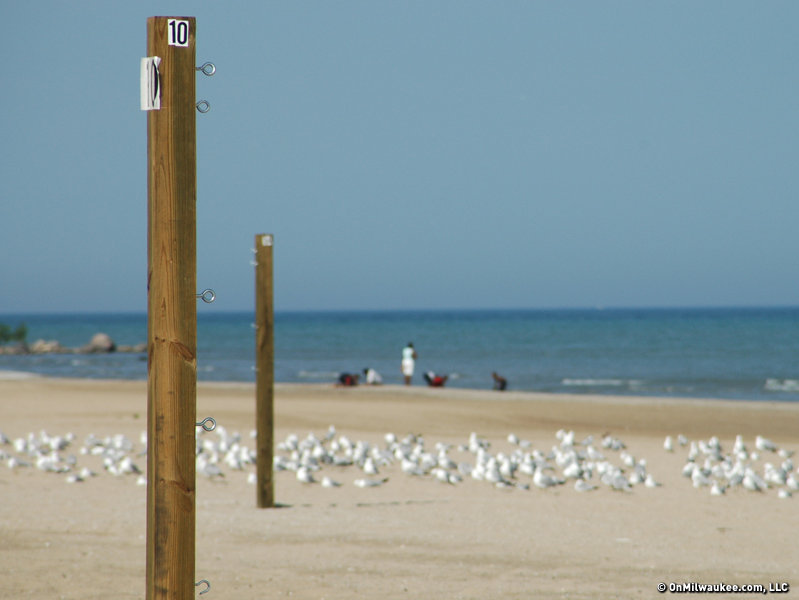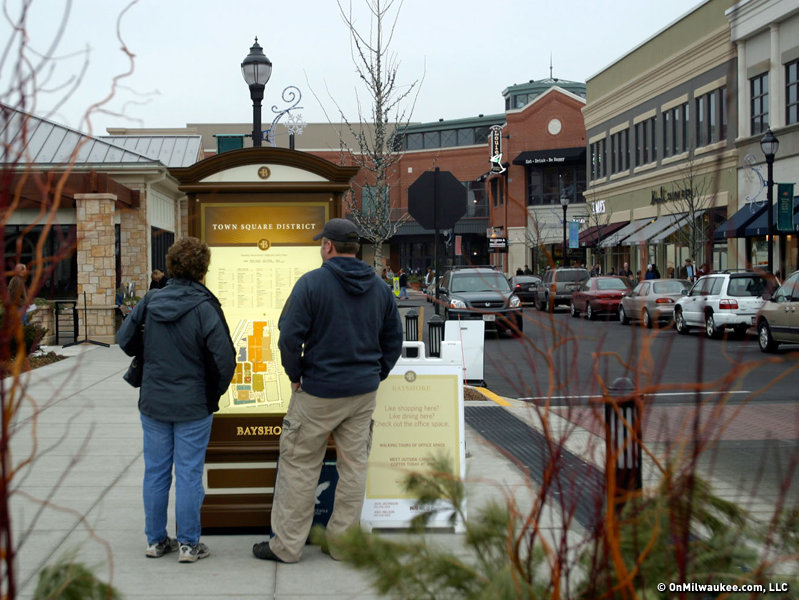Bear with us while explain the concept for this new series of articles: we take two seemingly unrelated Milwaukee icons, then pit them against each other in 10 categories. In each category, we'll assign them points, one through 10, then add them up and name the winner.
No, it's not scientific, but yes, it's fun. How does our favorite Great Lake stack up against our favorite building on the lake? Read on to find out ...
Affordability:
Lake Michigan, 10
You can't argue with free. Wisconsin's greatest natural resource costs absolutely nothing to use, that is, unless you count paying for a boat or a boat slip, bathing suit or a fishing pole.
Milwaukee Art Museum, 7
As top-notch art museums go, MAM is fairly inexpensive. For non-member adults, it costs $8 to view the exhibits. And residents of Milwaukee County can receive a free ticket every Wednesday.
Value to city:
Lake Michigan, 10
There's pretty much no way to overstate this. Lake Michigan brings everything from tourism to fish revenue, drinking water to recreational use. Go back far enough, and it's a main reason Milwaukee was settled in the first place.
Milwaukee Art Museum, 9
Considering the Calatrava-designed expansion was totally privately funded, and considering the MAM has redefined the city's skyline, it's extremely valuable as a symbol of the city's success. Though some aren't wild about the modern design, the official "mark" of Milwaukee contains the wings of the "Brise Soleil." Try to find another Milwaukee building with that much panache.
Popularity:
Lake Michigan, 7
It depends who you talk to, but while the lake remains a popular method for shipping and travel (see the Lake Express Ferry, for example), many Milwaukeeans tend to forget it's there. When was the last time you took a swim at Bradford Beach?
Milwaukee Art Museum, 7
See above. While art lovers remain thrilled with the traveling exhibits -- even if you drive past MAM every day, how many exhibits have you visited? All of them? Half of them? Or did you just go once to see what the fuss was all about?
Name recognition:
Lake Michigan, 10
Anyone in the world with a fifth grade education has at least heard of Lake Michigan. In Wisconsin, that might extend to anyone who's been in school past kindergarten.
Milwaukee Art Museum, 5
Locally, everyone knows about the Art Museum. It's received its share of national and international publicity. But to outsiders, MAM isn't as well-known as, say, the Sydney Opera House or Chicago's Museum of Science and Industry.
Design:
Lake Michigan, 9
It's hard to argue with 6,500-foot-thick glaciers that covered the area a million years ago. When they withdrew 10,000 years ago, they left the Great Lakes, that serve as the Midwest's only northeasterly access to the Atlantic Ocean (thanks to the St. Lawrence Seaway). If it wasn't for the rough water near the Upper Pennisula that has sunk many a ship, those stinky dead alewives, or that pesky lake-effect snow, Lake Michigan would earn a perfect 10 for design.
Milwaukee Art Museum, 6
The Art Museum is a strange mash-up between a 1957 and a 2001 design, with a clunky 1970s addition added to the mix. Each is unique and strangely beautiful, but the two buildings have no continuity between them. The new building, as far as art storage is concerned, isn't a home run, either -- since most of the space is actually used for special events.
Uniqueness:
Lake Michigan, 7
Lake Michigan is the fifth largest lake in the world, and it's the only Great Lake wholly within the United States. On the other hand, it's one of five Great Lakes, so it's not exactly one-of-a-kind.
Milwaukee Art Museum, 7
The design of the art museum, while not incredibly unique on its own (look at other Calatrava-designed works, you'll see the pattern) -- its shortcomings in the design category actually add to the unique factor. With half coming from the 1957 Eero Saarinen commission, and half coming from the Calatrava commission, there probably isn't another art museum in the world with two such radically different styles stuck together.
Economic value:
Lake Michigan, 10
Again, Lake Michigan, for reasons stated above, couldn't have more of an impact on Milwaukee. For the water table alone, it's a 10 (and would earn a higher number if the scale went higher).
Milwaukee Art Museum, 3
The economic value of the Art Museum comes primarily in general tourist dollars, as its presence makes for great postcards, photo shoots and art for civic leaders to hang their hats on. The revenue generated from MAM, specifically, isn't a huge impact, but what it does to the overall city image brings value.
Convenience factor:
Lake Michigan, 5
At 307 miles long, there are lots of ways to get to Lake Michigan. Several highways lead right to it, and public access is aplenty. But just by the nature of geography, it's convenient to people living close to it, and hours away from people living farther west.
Milwaukee Art Museum, 5
Fortunately, I-794 leads right to MAM, and even with the Marquette Interchange construction, it's easy to find. But the museum has a small underground parking lot, and free street parking is at a premium. During the summer, it's even harder to park close by.
History:
Lake Michigan, 10
Few things on Earth (that you'd play in, anyway) are more than 10,000 years old. Lake Michigan is big, deep and old, and steeped in Western and Native American history. The word "Michigan" comes from Ojibwa Indian word "mishigami," meaning "great water."
Milwaukee Art Museum, 6
Though it seems new, the museum's history began in 1888 when the Milwaukee Art Association was created by a group of German panorama artists and local businessmen; its first home was the Layton Art Gallery. The Milwaukee Art Center was formed when the Milwaukee Art Institute and Layton Art Gallery merged their collections in 1957. The latest addition opened May 4, 2001. There are certainly older art museums, but the MAM is no slouch, either.
Quality of product:
Lake Michigan, 7
With an average depth of 279 feet and a maximum depth of 923 feet, Lake Michigan is suited for vessels of all sizes. It's big enough to not freeze over, and it remains relatively clean, especially in Wisconsin. Unfortunately, some environmental problems still plague the lake. Steel mills are visible along the Indiana shoreline, and the pollution caused by these mills is believed to contribute to the color of sunsets. Also, the Chicago Tribune reported that BP is a major polluter, dumping thousands of pounds of ammonia and raw sludge into Lake Michigan every day from its Whiting, Ind. oil refinery. And of course, here in Milwaukee, we hear about the occasional sewerage dumping by the MMSD.
Milwaukee Art Museum, 8
For a museum of its size (and in a city of its size), MAM brings in some excellent art. Its permanent holdings contain an important collection of Old Masters and 19th-century and 20th-century artwork, as well as some of the nation's best collections of German Expressionism, folk and Haitian art, American decorative arts, and post-1960 American art. The museum holds a large number of works by Georgia O'Keeffe. Traveling exhibits have run the gamut from Degas to Francis Bacon to Pissarro and more.
Total:
Lake Michigan, 85
Milwaukee Art Museum, 63
Winner: Lake Michigan
Next up: Harley Davidson vs. The Domes
Andy is the president, publisher and founder of OnMilwaukee. He returned to Milwaukee in 1996 after living on the East Coast for nine years, where he wrote for The Dallas Morning News Washington Bureau and worked in the White House Office of Communications. He was also Associate Editor of The GW Hatchet, his college newspaper at The George Washington University.
Before launching OnMilwaukee.com in 1998 at age 23, he worked in public relations for two Milwaukee firms, most of the time daydreaming about starting his own publication.
Hobbies include running when he finds the time, fixing the rust on his '75 MGB, mowing the lawn at his cottage in the Northwoods, and making an annual pilgrimage to Phoenix for Brewers Spring Training.





